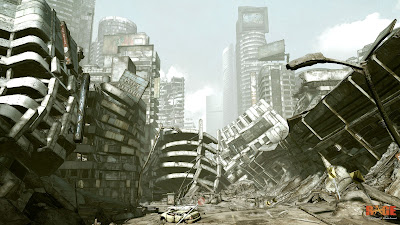Note: I've been toying with the idea of fully migrating this blog to Tumblr, but until I actually commit to that I'll continue to cross-post here.

One of Rage’s defining features, I found, was its focus on getting the player to push forward and become a driving force. This is embodied in its low-level combat mechanics, its mission structure and its narrative overtones.
The combat and mission structure empowers the player to press into hostile enemy territory and throw some rather large spanners into the works. There is often a strong sense that, until you showed up, those baddies were just going about their usual baddie business. This places the player in an active role which is characteristic of most id games, in contrast to the reactive role of Gordon Freeman in the first Half-Life, who’s just trying to get out alive.
Rage has drawn my attention to the slow pace commonly found in the modern CODesque cover-based shooters. In those games, player and enemy alike rely on ducking in and out of cover to take pop-shots. This creates a very detached experience in which you are waiting for brief glimpses of heads and torsos, waiting to clear an area so you can safely progress, waiting, waiting, waiting. In Rage you are very much capable of taking the fight directly to the enemy by storming their cover and tearing right through them. Conversely, the enemies who fight at close range will force you to move around a lot and engage with the intense spatial dynamics.
The story of Rage revolves around a man who brings disruption and chaos to the world, but I found this falls short in its execution. While the player’s character is touted as this powerful presence, their actions are the only thing that appears to move the plot forward in any meaningful way. This is extrapolated to the point of absurdity when every mission relies on the player going out to complete some difficult objective while the NPCs sit around and wait for their return. This is true right up to the games anti-climactic final mission, in which you must penetrate the impenetrable fortress and do something or other while your mission-givers stand on the spot and do… nothing. Half-Life 2 - the almighty benchmark against which I compare most games - at least gave the impression that everyone else was kind of busy not dying.
Lesson learned: make the player feel like they have an effect on the world, but also make them feel like the other characters are actually capable of doing something too.
No comments:
Post a Comment